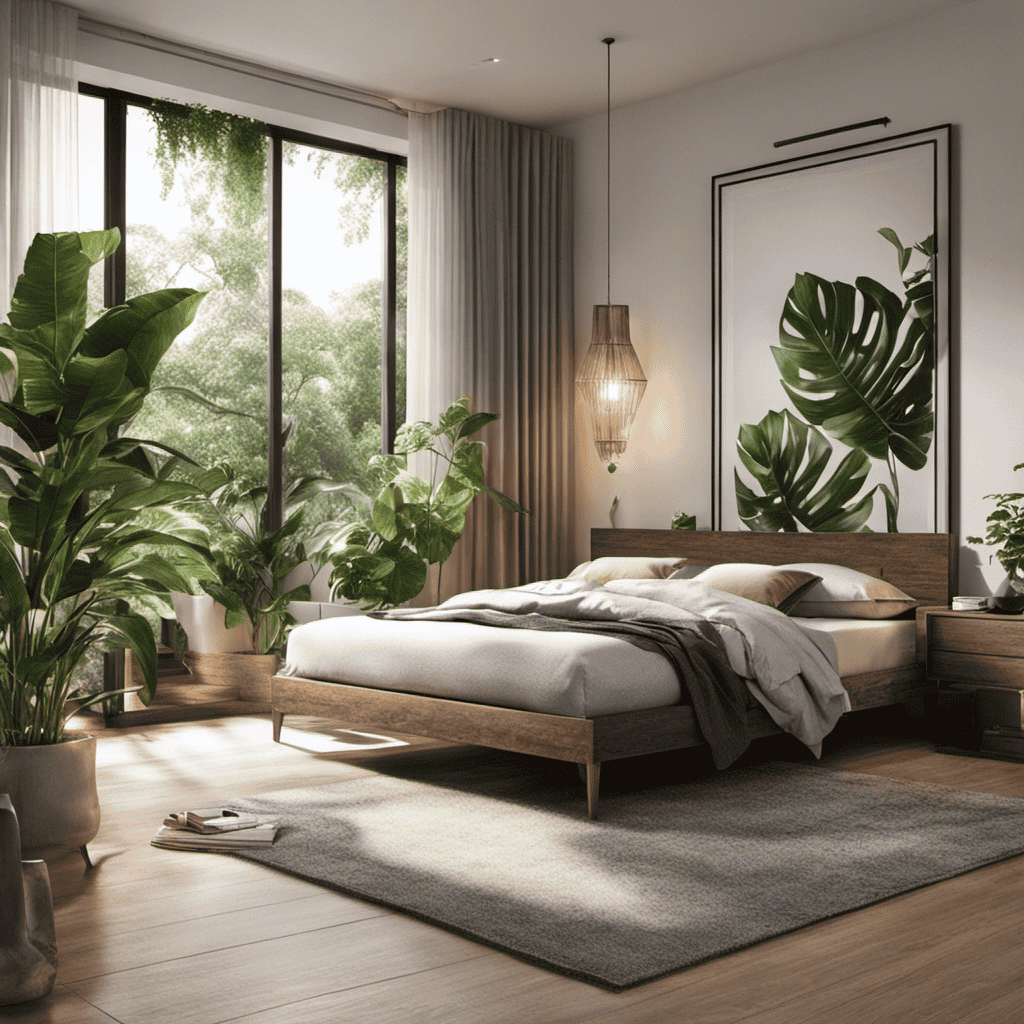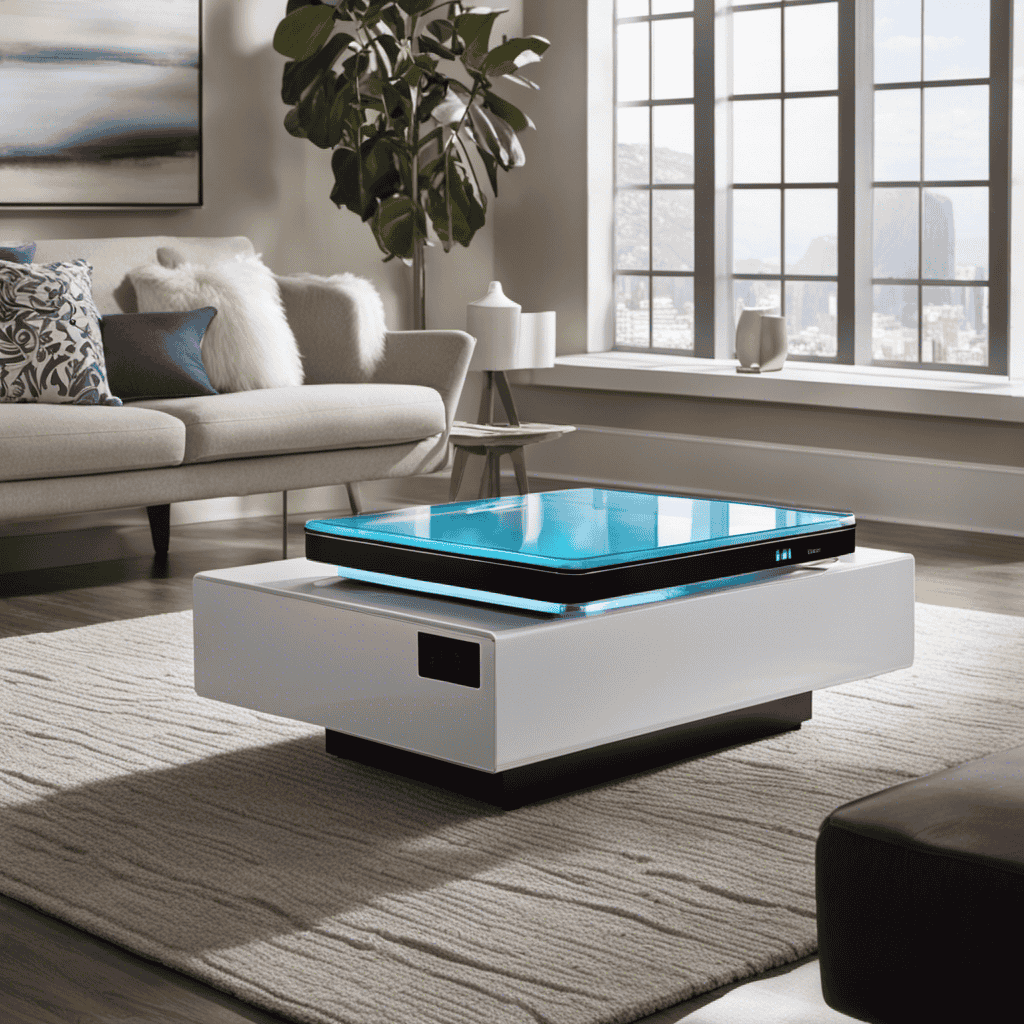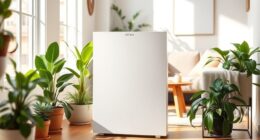I have to admit, finding the ideal location for your air purifier can be quite tricky. However, rest assured, I have conducted the research for you.
In this article, we’ll dive into the Reddit community’s insights on the best placements for air purifiers in different areas of your home. From bedrooms to basements, kitchens to offices, we’ve got you covered.
So sit back, relax, and let’s find the ideal spot to breathe in that clean, fresh air.
Key Takeaways
- Bedroom Placement: Directly targets the air you breathe while sleeping and improves air circulation in bedrooms.
- Living Room Placement: Find the best corner for optimal air circulation and capture pollutants as they enter the room.
- Near Windows or Not: Consider potential drafts and balance fresh air intake with exposure to outdoor pollutants.
- Distance From Furniture: Maintain proper distance for better air flow and minimize noise and vibration.
Bedroom Placement
You should put your air purifier in your bedroom for the best results. Bedroom placement is important because it allows the air purifier to directly target the air you breathe while you sleep.
One of the main benefits of having an air purifier in your bedroom is improved air circulation. This is especially important if your bedroom doesn’t have good natural ventilation. The air purifier can help remove dust, allergens, and pollutants, creating a cleaner and healthier environment for sleeping.
Another factor to consider is the noise levels of the air purifier. Many air purifiers have different fan speeds, and you may want to choose a quieter setting for your bedroom to ensure a peaceful and undisturbed sleep.
Now let’s move on to the next section about living room placement.
Living Room Placement
When it comes to placing an air purifier in the living room, there are a few key factors to consider.
Firstly, finding the best corner for the air purifier is crucial for optimal air circulation and effectiveness.
Secondly, it’s important to decide whether placing the air purifier near windows is advantageous or not, taking into account factors such as outdoor air quality and potential drafts.
Lastly, considering the distance from furniture is important to ensure that the air purifier has enough space to function efficiently without any obstructions.
Best Corner for Air Purifier
The best corner for an air purifier is usually near a power outlet. This allows for easy access to electricity and ensures that the purifier can effectively clean the air in the room. When considering where to place your air purifier, it’s important to take into account the layout of the room and any potential obstructions that may hinder airflow. Additionally, consider your specific needs and preferences for the room. For example, in a bedroom, you may want to place the air purifier near the bed to maximize its effectiveness while you sleep. In a home office setup, placing the purifier near your desk can help create a clean and healthy working environment. Ultimately, the best corner for your air purifier will depend on your unique circumstances and the specific needs of the room.
| Purifier Placement Ideas | Pros | Cons |
|---|---|---|
| Near a Power Outlet | Easy access to electricity | Limited placement options |
| Near the Bed | Maximize effectiveness while sleeping | Limited coverage for the entire room |
| Near the Desk | Create a clean and healthy working environment | Limited coverage for the entire room |
| Near the Entrance | Capture pollutants as they enter the room | May obstruct the flow of foot traffic |
Near Windows or Not
If you’re considering placing your air purifier near windows, it’s important to be mindful of potential drafts that could affect its performance.
When it comes to choosing between the bedroom and the living room for air purifier placement, there are pros and cons to placing it near a window.
One advantage is that windows can provide a source of fresh air for the purifier to filter. However, this also means that the purifier may be exposed to outdoor pollutants, such as pollen or pollution, which could decrease its effectiveness.
Additionally, drafts from windows can disrupt the airflow of the purifier, reducing its efficiency. Therefore, it is crucial to strike a balance between finding a location near a window that allows for fresh air intake, while also minimizing drafts.
Speaking of location, let’s now discuss the ideal distance from furniture for optimal air purifier performance.
Distance From Furniture
To maximize the performance of your air purifier, make sure it’s placed at an optimal distance from furniture. Placing the air purifier too close to furniture can hinder its ability to effectively circulate and filter the air in the room.
Here are a few reasons why maintaining a proper distance is important:
-
Ensures proper air flow: Keeping the air purifier at least a few feet away from furniture allows for better air circulation and prevents any obstruction that may hinder the purification process.
-
Reduces noise: Placing the air purifier away from furniture can help minimize any noise or vibration caused by the machine, allowing for a more peaceful and uninterrupted sleep.
-
Distance from pets: If you have pets, keeping the air purifier away from furniture can help prevent them from knocking it over or interfering with its operation.
-
Impact on sleep quality: Optimal placement of the air purifier can improve the overall air quality in your bedroom, leading to better sleep and overall well-being.
Kitchen Placement
Consider placing your air purifier in the kitchen to help remove odors and improve air quality while you cook.
When deciding on the best location for your air purifier, the kitchen counter and under the sink are two options worth considering.
Placing the air purifier on the kitchen counter allows it to be easily accessible and ensures a more efficient airflow throughout the room. This placement is particularly useful if you have a small kitchen or limited space.
On the other hand, if you have enough space under your sink, placing the air purifier there can be a great alternative. It keeps the purifier out of sight while still effectively reducing odors and improving air quality.
Now, let’s move on to the next section about office placement.
Office Placement
When it comes to placing an air purifier in the office, there are a few key considerations to keep in mind.
First, should you place it on your desk or on the floor? While placing it on the desk may provide more immediate benefits, placing it on the floor allows for better air circulation throughout the room.
Additionally, it is important to consider whether to place the air purifier near windows or not. While placing it near windows may help to filter out outdoor pollutants, it may also introduce additional dust and allergens.
Lastly, it is crucial to consider the distance from electronics. Air purifiers generate a small amount of ozone, which can be harmful to electronic devices, so it is best to keep a safe distance to avoid any potential damage.
Desk or Floor
Place your air purifier on either your desk or the floor to maximize its effectiveness. When deciding where to put your air purifier, consider the specific room you are in and its unique air quality needs.
Here are some factors to consider:
-
Bedroom vs. living room: If you are placing the air purifier in your bedroom, the floor might be a better option as it can help remove allergens that settle on the ground. In the living room, placing it on the desk can help to circulate the purified air more efficiently.
-
Office vs. kitchen: In an office setting, having the air purifier on the desk can help to filter out dust and particles that might be present in the surrounding area. In the kitchen, placing it on the floor can help to capture cooking odors and airborne contaminants.
-
Personal preference: Ultimately, the placement of the air purifier depends on your personal preference and the specific layout of the room.
Considering these factors, you can now make an informed decision about where to place your air purifier.
In the next section, we will discuss whether it is beneficial to place the air purifier near windows or not.
Near Windows or Not
To maximize the effectiveness of your air purifier, you may want to think about whether placing it near windows is beneficial or not. Some people believe that placing an air purifier near windows can help to filter out outdoor pollutants, such as pollen or dust, that may enter through the window. However, it’s important to consider the potential drawbacks as well. Depending on the location of your windows, placing an air purifier near them could also expose it to outdoor pollutants, such as car exhaust or industrial emissions. Additionally, if the air purifier is too close to the window, it may be influenced by drafts or temperature fluctuations. Ultimately, the best placement for your air purifier will depend on the specific layout of your space and your individual needs.
| Bedroom | Living Room | Kitchen | Office | |
|---|---|---|---|---|
| Windows | ✔️ | ❌ | ✔️ | ❌ |
| Advantages | Filters outdoor pollutants, improved air quality. | May expose purifier to outdoor pollutants. | Filters cooking odors, improves air quality. | May be influenced by drafts or temperature fluctuations. |
| Disadvantages | May be influenced by drafts or temperature fluctuations. | Filters outdoor pollutants, improved air quality. | May expose purifier to outdoor pollutants. | Filters cooking odors, improves air quality. |
Distance From Electronics?
When it comes to placing an air purifier near electronics, it’s important to consider the safe distance that should be maintained. While air purifiers are generally safe to use around electronic devices, keeping a certain distance can prevent any potential interference or damage to the electronics. Here are some key points to keep in mind:
- Maintain a distance of at least 3 feet between the air purifier and electronics.
- Avoid placing the air purifier directly on top of or next to electronic devices.
- Keep the air purifier away from any vents or openings on electronic devices.
- Consider using a surge protector to protect your electronics from any potential power fluctuations caused by the air purifier.
By following these guidelines, you can ensure that your electronic devices remain unaffected by the presence of an air purifier.
Now, let’s move on to the next section about the placement of air purifiers in basements.
Basement Placement
If you’re considering putting your air purifier in the basement, make sure to choose a location that allows for proper air circulation. Basements can often have higher humidity levels compared to other areas of the house, so it’s important to take this into account.
Excessive humidity in the basement can lead to mold and mildew growth, which can affect the air quality. To combat this, ensure that your basement has adequate ventilation. This can be achieved through the use of windows, vents, or a dehumidifier if necessary.
By improving basement ventilation, you can help create a healthier environment for your air purifier to work effectively.
Now, let’s move on to the next section about bathroom placement.
Bathroom Placement
Consider placing your air purifier in the bathroom. This area of your home can often have a higher concentration of pollutants such as odors, mold, and bacteria. The bathroom is a space where shower humidity can accumulate, creating an environment that is conducive to the growth of mold and bacteria.
By placing an air purifier in the bathroom, you can effectively remove these harmful particles from the air, improving the overall air quality. Additionally, an air purifier in the bathroom can help control unpleasant odors that may linger after using the toilet or showering. With its ability to capture and eliminate these odors, the air purifier can ensure a fresh and clean environment.
Now, let’s move on to discussing the placement of air purifiers in nurseries.
Nursery Placement
To create a safe and clean environment for your baby, placing an air purifier in the nursery is highly recommended.
Nursery safety is of utmost importance, and ensuring that the air your little one breathes is free from pollutants is essential. An air purifier can help remove allergens, dust, and other airborne particles, improving the air quality and reducing the risk of respiratory issues.
When it comes to nursery decor, you can find air purifiers in various designs and sizes to match your nursery theme. Look for purifiers with HEPA filters, as they are highly efficient in capturing even the smallest particles.
Additionally, consider placing the air purifier away from the crib, but still within the nursery, to ensure proper air circulation and filtration.
Pet Area Placement
Placing an air purifier near your pet’s area can help improve air quality and reduce allergens. As a pet owner, I understand the importance of keeping my furry friend healthy and comfortable. Here are some key tips for placing an air purifier in your pet’s area:
- Consider the size of the room and choose an air purifier that can effectively cover the space.
- Opt for a pet-friendly air purifier that is designed to capture pet dander, hair, and odors.
- Regularly clean and maintain the air purifier to ensure optimal performance. Replace filters as recommended by the manufacturer.
- Place the air purifier in a central location to maximize air circulation and filtration.
Allergy Relief Placement
While it’s important to consider pet areas when placing an air purifier, another key factor is addressing allergy relief. Allergens such as dust mites, pollen, and mold can wreak havoc on sensitive individuals.
When it comes to bedroom decor, it’s crucial to choose an air purifier that not only fits seamlessly into the aesthetic but also effectively filters out allergens. Look for models with HEPA filters, as they can capture particles as small as 0.3 microns. Placing an air purifier near outdoor areas can also help reduce the influx of outdoor allergens. For example, if you have a window in your bedroom, positioning the air purifier nearby can intercept pollen before it enters the room.
Transitioning from bedroom decor and outdoor placement, let’s now discuss the importance of placing air purifiers in high traffic areas.
High Traffic Area Placement
When it comes to placing an air purifier in a high traffic area, there are a few key considerations to keep in mind.
One of the main factors to consider is whether to opt for central or peripheral placement.
Central placement involves positioning the air purifier in the center of the room, while peripheral placement involves placing it near the walls or corners.
Both options have their pros and cons in terms of accessibility and effectiveness, and it’s important to weigh these factors carefully before making a decision.
Central Vs. Peripheral Placement
To get the best results, you should consider whether central or peripheral placement of your air purifier is more effective.
When deciding where to place your air purifier, keep in mind the optimal room size and the airflow patterns in your space. Here are some factors to consider:
-
Central Placement:
-
Allows for better coverage throughout the room
-
Helps to evenly distribute purified air
-
Can be more effective in larger rooms
-
Ideal for open floor plans or rooms with multiple entrances
-
Peripheral Placement:
-
Targets specific areas for purification
-
Can be effective in smaller rooms or areas with localized pollution sources
-
May be more convenient for placement near electrical outlets or furniture
Ultimately, the best placement for your air purifier depends on the size of your room and your specific needs. Consider experimenting with different locations to find the optimal placement for clean and fresh air.
Accessibility and Effectiveness
The accessibility and effectiveness of your air purifier depend on its placement in the room. When it comes to improving bedroom air quality, proper placement is crucial. Research shows that placing the air purifier near the center of the room allows for better air circulation and ensures that the purifier can effectively remove pollutants from the entire space.
Additionally, maintaining your air purifier is essential for optimal performance. Regularly cleaning or replacing the filters, as recommended by the manufacturer, helps to maintain the purifier’s efficiency and prolong its lifespan. By following these maintenance guidelines, you can ensure that your air purifier is working at its best to keep your bedroom air clean and healthy.
Now, let’s explore the benefits of placing the purifier near windows.
Near Windows Placement
Placing the air purifier near windows can help improve air circulation in the room. This placement allows the purifier to draw in fresh outdoor air and expel indoor pollutants. However, there are pros and cons to consider when placing your air purifier near windows.
Pros of near window placement:
- Increased air circulation: The purifier can intake fresh air from outside, ensuring better ventilation.
- Natural light: Placing the purifier near a window allows it to benefit from natural sunlight, which can help kill bacteria and mold.
Cons of near window placement:
- Outdoor pollutants: If the air quality outside is poor, the purifier may draw in polluted air, defeating its purpose.
- Noise: Depending on the location, noise from traffic or outdoor activities may disrupt the quiet atmosphere inside.
Considering these factors, it is important to find the best time for placement and assess the air quality in your area before deciding to place your air purifier near a window.
Near Electronics Placement
When it comes to placing electronics near air purifiers, there are a few key points to consider.
Firstly, it is recommended to maintain a safe distance of at least three feet between the air purifier and any electronic devices. This helps to minimize any potential interference that may occur.
Secondly, it is important to note that air purifiers generally do not have a significant impact on the performance of electronic devices. However, it is always a good idea to refer to the manufacturer’s guidelines for specific recommendations.
Safe Distance From Electronics
You shouldn’t place the air purifier too close to electronics because it can interfere with their performance. It’s important to consider the distance between the air purifier and other appliances in order to maintain optimal air quality. Here are a few key points to keep in mind:
-
Maintain a distance: Place the air purifier at least 3 feet away from electronics to minimize any potential interference.
-
Avoid blocking air flow: Make sure there is ample space around the purifier to allow for proper air circulation.
-
Consider placement: Find a spot for the air purifier that is away from direct sunlight, as excessive heat can impact its performance.
-
Avoid corners: Placing the purifier in corners can restrict the airflow, so it’s best to position it in a more central location.
Impact on Device Performance
To minimize any potential interference, it’s important to keep the air purifier at least 3 feet away from your electronics. Placing the air purifier on a desk or floor near your electronics can have an impact on their performance.
Research suggests that when an air purifier is positioned too close to devices like computers or televisions, it may cause electromagnetic interference, leading to issues such as flickering screens or disrupted Wi-Fi connections.
It’s essential to find a balance between central and peripheral placement. Placing the air purifier in a central location can help improve air circulation and ensure that all areas of the room are properly purified. However, keeping it towards the periphery can prevent any potential interference with your electronics.
Now, let’s discuss the placement of air purifiers in small apartments.
Small Apartment Placement
For a small apartment, it’s important to find a suitable spot for your air purifier. Here are some tips to help you maximize its effectiveness in a limited space:
- Place the air purifier in the center of the room to ensure better air circulation.
- Avoid placing it near walls or furniture that may obstruct the airflow.
- Keep it away from direct sunlight or heat sources, as it can affect its performance.
- Consider placing it at a higher level, such as on a shelf or table, to optimize its reach.
When choosing an air purifier for small spaces, look for compact models that can effectively clean the air in your apartment. Consider the size of the room and the purifier’s coverage area to ensure efficient purification. Additionally, check the noise levels to ensure it won’t disturb your living space.
Large Home Placement
When considering placement in a large home, it’s important to find a central location for optimal air purifier effectiveness.
In a large home, you want to ensure that the air purifier is placed in an area where it can effectively circulate clean air throughout the entire space. This means avoiding placing it in corners or behind furniture that can obstruct the airflow.
Additionally, the size of the air purifier is crucial for large homes. Larger homes require air purifiers with higher CADR (Clean Air Delivery Rate) to efficiently purify the air in larger rooms.
It is recommended to choose an air purifier with a CADR rating that matches the square footage of the room it will be placed in. This will ensure that the air purifier can effectively clean the air in a large home.
Open Concept Layout Placement
In an open concept layout, it’s crucial to consider placing the air purifier in a central location to effectively circulate clean air throughout the entire space. When deciding on the placement of your air purifier, keep in mind the following factors:
-
Proximity to Kitchen Island: Placing the air purifier near the kitchen island can help remove cooking odors and airborne particles that may be produced during meal preparation.
-
Distance from Dining Room Table: Consider placing the air purifier at a suitable distance from the dining room table to prevent any disruption to your dining experience while still ensuring clean air in the area.
-
Coverage Area: Make sure the air purifier is strategically positioned to cover the maximum area possible, including adjacent rooms or hallways.
-
Obstructions: Avoid placing the air purifier in areas with obstructions such as furniture or curtains, as these could hinder the circulation of clean air.
Frequently Asked Questions
Can I Place an Air Purifier in My Garage or Outdoor Area?
Yes, you can place an air purifier in your garage or outdoor area. However, it may not be as effective as using it indoors. Air purifiers are commonly used in basements and greenhouses.
Should I Place an Air Purifier in My Laundry Room?
Sure! In my opinion, placing an air purifier in the laundry room can be beneficial. It helps remove pollutants like lint, dust, and odors, ensuring cleaner air. Consider factors like size, filtration system, and noise level when choosing one.
Is It Necessary to Have an Air Purifier in My Dining Room?
It’s important to consider placing an air purifier in the dining room for improved air quality. Air purifiers can help remove allergens, dust, and odors, creating a healthier environment for meals and preventing potential health issues.
Can I Use an Air Purifier in My Car?
Yes, you can use an air purifier in your car. It can provide numerous benefits like removing dust, allergens, and odors. When choosing one, consider the size, filtration system, and power source that suits your vehicle.
Should I Place an Air Purifier in My Walk-In Closet?
I pondered about placing an air purifier in my walk-in closet. Should I also put one in my bedroom? What about my office? I needed to find research-based answers to make an informed decision.
Conclusion
In conclusion, it’s important to consider the specific needs and layout of your home when placing your air purifier. Whether you choose to put it in the bedroom, living room, or kitchen, the ultimate goal is to improve your indoor air quality.
Putting the air purifier in the bedroom can provide a peaceful night’s sleep, while placing it in the living room ensures clean air while relaxing. On the other hand, placing it in the kitchen can help combat cooking odors.
Just like a lighthouse guides ships safely to shore, an air purifier can become the beacon of fresh air, guiding you towards a healthier and cleaner home. So, find the perfect spot for your air purifier and let it illuminate your path to a breath of fresh air.










